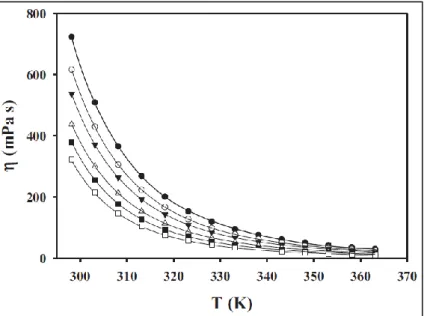New low transition temperature (LTTM) mixtures based on three different molar ratios of hydrogen bond donor (HBD) in glyceline from (choline chloride:glycerol and 1:4 with L-arginine (L-Arg) are successfully synthesized with different molar ratios between glycelin to L-Arg.The physical properties, such as density, viscosity and refractive index of LTTM are measured at atmospheric pressure and temperature of (298.15 to 343.15) K with an interval of 5 K. The results showed that different molar ratios of HBD in glyceline, the molar ratio of glyceline to L-Arg and temperature greatly influence both the physical and thermal properties of LTTM.
The density and viscosity of LTTM formed by glycerin and L-Arg decrease with increasing temperature, but increase with increasing mole ratio of HBD and L-Arg. The refractive indices of LTTM decrease with increasing temperature and HBD mole ratio, but increase with decreasing L-Arg mole ratio.
- Background
- Problem Statement
- Objectives
- Scope of Study
Current DES and LTTM are dominated by binary mixtures between halide salts and HBD (i.e. it is important to find a viable alternative to expensive RTIL while bridging the performance gap between DES and LTTM with current adsorption technology amines.Variation of the ternary compositions of DES and LTTM will result in different eutectic mixture molar ratios, different physical properties and different levels of CO2 absorption performance.
Subsequently, the effects of ternary components in DES and LTTM will be studied, such as CO2 absorption and physical properties. The resulting DES and LTTM are considered successful as long as a colorless, clear solution is formed within an acceptable time frame.
![Figure 2. Amines forming stable carbamates or bicarbonates with CO 2 [9]](https://thumb-ap.123doks.com/thumbv2/azpdforg/10242714.0/13.892.260.694.810.969/figure-amines-forming-stable-carbamates-bicarbonates.webp)
Room-Temperature Ionic Liquids (RTIL), Deep Eutectic Solvents (DES) and Low
In general, DES can be described by the general formula Cat+X–zY, where Cat+ is basically any ammonium, phosphonium or sulfonium cation and X is a Lewis base, usually a halide anion. A recent breakthrough suggests that the scope of deep eutectic solvents can be broadened by replacing unhydrated metal halides with hydrated metal halides (type II DES). The wide range of HBD available means that this class of deep eutectic solvent is particularly flexible.
The physical properties of the fluid depend on the HBD and can be easily tailored to specific applications. Furthermore, DES can be produced from biodegradable compounds whose toxicology is well characterized and may even include the use of vitamins and metabolites.
![Table 1. General Formula for the Classification of DES [31]](https://thumb-ap.123doks.com/thumbv2/azpdforg/10242714.0/18.892.180.778.594.759/table-general-formula-classification-des.webp)
Physical Properties Characterization
- Melting Point (MP)
- Glass Transition Temperature (T g )
- Density, Viscosity and Refractive Index
In the same study, the lowering of the freezing point is shown to be related to the mass fraction of HBD in the mixture. It can be inferred that higher concentrations of HBD decrease the strength of the hydrogen bonding interactions in the same way as postulated for the changes in viscosity with HBD concentration. However, a different trend is observed in the DES system consisting of potassium carbonate (K2CO3) and glycerol (GLY).
The origin of this disparity is assumed to be due to the large size of the ions and the relatively free volume in the systems. Surface tension can be expected to follow similar trends to viscosity as it is a measure of how strong the intermolecular forces are in the liquid, similar to the measure of viscosity.
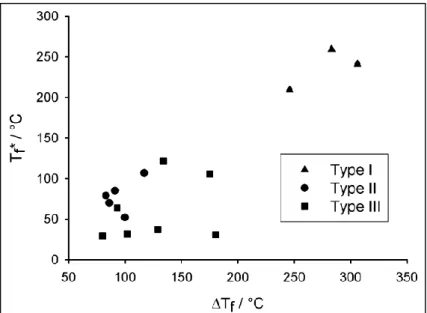
Material Selection
- Choline Chloride (ChCl)
- Glycerol (Gly)
- L-Arginine (L-Arg)
It is reasonable to expect that as the molar composition of ChCl increases, the surface tension will also increase as the molar composition of ChCl increases [43]. Perhaps the most studied DES is based on ChCl (also known as (2-hydroxyethyl)trimethylammonium chloride). The choline cation belongs to an important class of the B vitamin family and is considered to play an essential role in our daily lives by assisting in various metabolic mechanisms [18, 19].
Gly (1, 2, 3-propanetriol) is a non-toxic, colorless, odorless, viscous liquid with a sweet taste, obtained from natural and petrochemical raw materials. The name glycerol is derived from the Greek word for sweet (glykys), and the terms glycerin, glycerin and glycerol are used interchangeably in the literature [30]. Amino acids are biologically important organic compounds consisting of amine (–NH2) and carboxylic acid (–COOH) functional groups, together with a side chain specific to each amino acid.
It can be divided based on their structure and the general chemical characteristics of their functional groups (Figure 19). The guanidinium group of L-Arg is positively charged in neutral, acidic and even more basic environments, and thus gives arginine basic chemical properties. Due to the conjugation between the double bond and the nitrogen lone pairs, the positive charge is delocalized, enabling the formation of multiple H bonds (Figure 18).
![Table 5. Properties of ChCl [44]](https://thumb-ap.123doks.com/thumbv2/azpdforg/10242714.0/32.892.258.698.378.575/table-properties-of-chcl.webp)
- Materials and Apparatus
- Methodology
- Synthesis of LTTM System
- Characterization of LTTM
- Project Feasibility
- Gantt Chart and Key Milestones
The prepared DES/LTTM is selected based on the structure of salts and the HBD. To prepare our DES/LTTM mixtures, a binary DES mixture of ChCl and Gly is first prepared by mixing ChCl and Gly in the correct molar ratio with vigorous stirring at 80°C for 30 minutes. Stirring is continued for an additional hour without heating, allowing the mixture to cool to room temperature.
Next, LTTM for ChCl, Gly and ternary component is prepared by heating the binary DES to 80 °C followed by adding the appropriate mass of the ternary component with stirring. The final mixture is then stirred for up to 2 hours to ensure homogeneity of resulting LTTM before allowing it to cool to ambient temperature. The solution is left overnight at room temperature to ensure that no precipitation of the ternary component took place.
It is important to note that no purification step is required and no additional solvents are used in the preparation of this LTTM. In addition, a reasonable and detailed schedule has been prepared for each part of the project so that the project can be completed within the scheduled time and will yield a good result at the end.
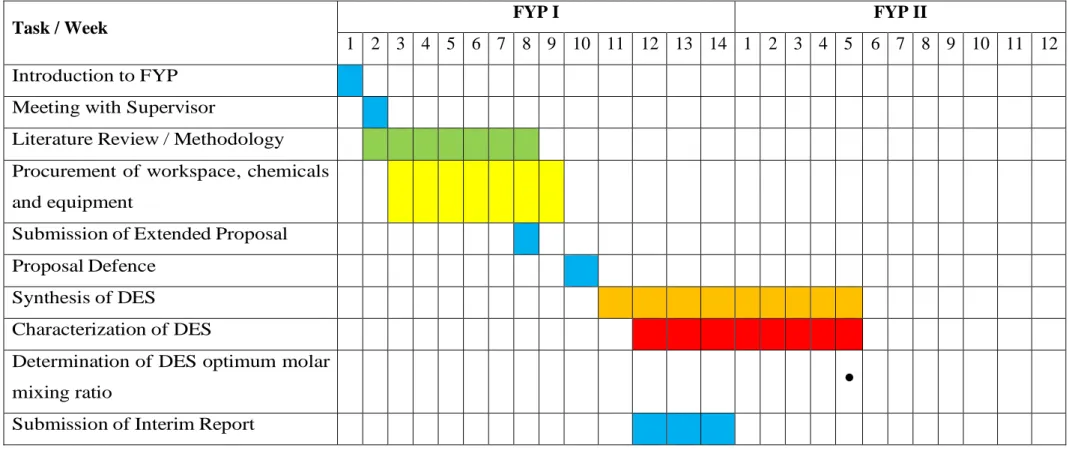
- Formation of Solvents
- Water Content
- Thermal Properties
- Decomposition Temperature
- Melting Point / Glass Transition Temperature (MP / T g )
- Physical Properties
- Density
- Viscosity
- Refractive Index
𝑅𝐴𝑟𝑔𝑖𝑛𝑖𝑛𝑒 = 0.2 𝑅𝐺𝑙𝑦𝑐𝑒𝑟𝑜𝑙− 0.2 Equation 6 Here RArginine and RGlycerol refer to the molar ratio of the components in the ternary deep eutectic solvent system. The accuracy of the TGA result in determining the decomposition temperature of DES can be affected by various operating parameters and conditions, such as heating rate, temperature, pressure, moisture content, and sample composition. As observed in Table 14, the decomposition temperature of DES/LT™ decreased with arginine added to the system.
As the glycerol and arginine content in DES/LTTM increased, the thermal stability of DES generally decreased. The increase in thermal stability suggests that a molar ratio of 0.2 arginine forms a strong hydrogen bond with the free glycerol in the glyceline 1:4 system. Differential scanning calorimetry (DSC) is performed on all binary and ternary DES/LTTM to determine the MP/Tg of DES/LTTM.
The accuracy of the DSC result for determining the MP/Tg of DES/LTTM can be affected by various operating parameters and conditions, such as heating rate, temperature, pressure, moisture content and composition of the sample. Under the above operating conditions and scanning program, the MP/Tg of the DES/LTTM is studied at the intersection of extrapolated constant mass and the slope of the mass loss at the inflection point. The density of binary DES increased with increasing molar ratio of glycerol, and the density of ternary DES increased with the increased addition of l -arginine.
The dotted lines in Figure 24 show that the density of DES can be fitted linearly in the form of Equation 8. The viscosity of DES is measured as a function of temperature and is shown in Figure 25 and Tables 20 to 22. Refractive index is the ratio from the speed of light (sodium D-line, 589 nm wavelength [55]) in air to the speed of light in the solvent.
The refractive index of DES was measured as a function of temperature and is shown in Figure 27 and Tables 24 to 26. It can be seen that the refractive index of DES decreases with increasing glycerol and increases with increasing arginine in the system.
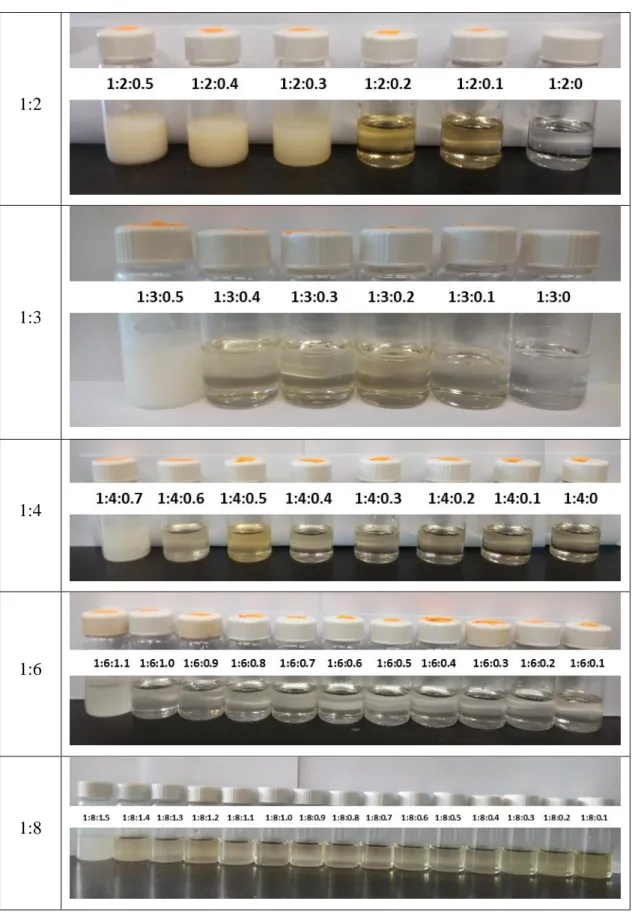
He, “Solubilities and thermodynamic properties of CO2 in choline-chloride-based deep eutectic solvents,” The Journal of Chemical Thermodynamics , vol. Yamasaki, "A Review of CO2 Mitigation Options for Global Warming—Emphasizing CO2 Sequestration Options," JOURNAL OF CHEMICAL ENGINEERING OF JAPAN, vol. Maurer, "Solubility of CO2 in the ionic liquid [hmim][Tf2N]," The Journal of Chemical Thermodynamics, vol.
DePaoli, “Low-pressure solubility of carbon dioxide in ionic liquids at room temperature, measured by a quartz crystal microbalance,” The Journal of Physical Chemistry B, vol. Brennecke, "High-pressure phase behavior of ionic liquid/CO2 systems", The Journal of Physical Chemistry B, vol. Shreeve, "Rapid and Accurate Estimation of Densities of Room Temperature Ionic Liquids and Salts," The Journal of Physical Chemistry A, vol.
34;Deep Eutectic Solvents Formed between Choline Chloride and Carboxylic Acids: Versatile Alternatives for Ionic Liquids," Journal of the American Chemical Society, vol. Gano, "Potassium Carbonate as a Salt for Deep Eutectic Solvents," International Journal of Chemical Engineering and Applications , vol Pandey, “Densities and dynamic viscosities of (choline chloride+glycerol) deep eutectic solvent and its aqueous mixtures in the temperature range K,” Fluid Phase Equilibria , vol.
Li, “Densities of a deep eutectic solvent based on choline chloride and glycerol and its aqueous mixtures at elevated pressure,” Fluid Phase Equilibria , vol. 34;Ternary Deep Eutectic Solvents Tasked for Carbon Dioxide Capture," Acs Sustainable Chemistry & Engineering, vol. Li, "Solubility of Carbon Dioxide in a Eutectic Mixture of Choline Chloride and Glycerol at Moderate Pressure," The Journal of Chemical Thermodynamics, vol.
Li, "Henry's constant of carbon dioxide-aqueous deep eutectic solvents (choline chloride/ethylene glycol, choline chloride/glycerol, choline chloride/malonic acid) systems". 34; Non-isothermal thermogravimetric pyrolysis kinetics of waste oil refinery sludge by isoconversion approach," Journal of Thermal Analysis and Calorimetry, vol.
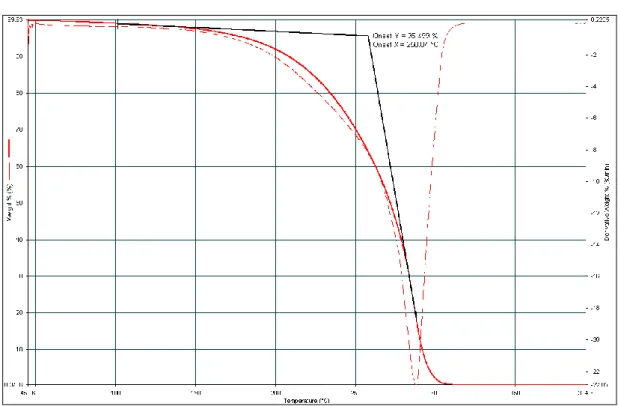
![Figure 3. Structures of some halide salts and hydrogen bond donors used in the formation of deep eutectic solvents [31]](https://thumb-ap.123doks.com/thumbv2/azpdforg/10242714.0/19.892.264.693.682.982/figure-structures-halide-hydrogen-donors-formation-eutectic-solvents.webp)
![Figure 4. Schematic representation of a eutectic point on a two component phase diagram [31]](https://thumb-ap.123doks.com/thumbv2/azpdforg/10242714.0/20.892.263.691.404.711/figure-schematic-representation-eutectic-point-component-phase-diagram.webp)
![Figure 6. Schematic representation of exceptional cases of two eutectic points on a two component phase diagram [35]](https://thumb-ap.123doks.com/thumbv2/azpdforg/10242714.0/23.892.264.692.108.487/figure-schematic-representation-exceptional-eutectic-points-component-diagram.webp)
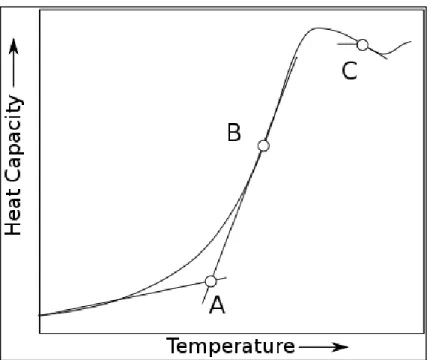
![Figure 8. T g against different molar ratio of Gly observed for the DES between K 2 CO 3 and Gly ratios studied in [30]](https://thumb-ap.123doks.com/thumbv2/azpdforg/10242714.0/25.892.262.691.108.396/figure-different-molar-ratio-gly-observed-ratios-studied.webp)
![Figure 9. DSC curves showing the trend of T g for different lactic acid: choline chloride ratios [29]](https://thumb-ap.123doks.com/thumbv2/azpdforg/10242714.0/26.892.266.692.102.688/figure-curves-showing-different-lactic-choline-chloride-ratios.webp)
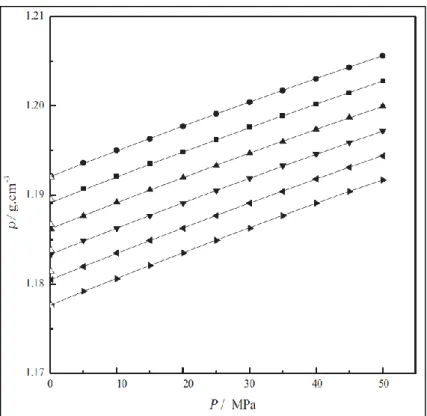
![Figure 11. Shear rate–dependent viscosity of 1:2:6 ChCl: Gly: 1,5- 1,5-Diazabicyclo[4.3.0]non-5-ene (DBN) measured at 298.15K [42]](https://thumb-ap.123doks.com/thumbv2/azpdforg/10242714.0/29.892.264.695.108.414/figure-shear-rate-dependent-viscosity-chcl-diazabicyclo-measured.webp)
